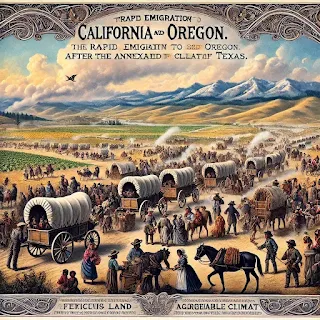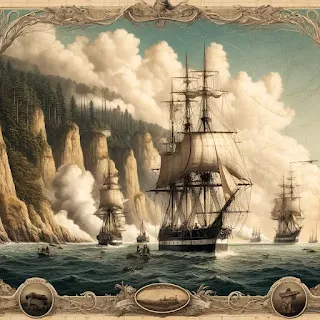The Drive West
The article discusses the rapid increase in emigration to California and Oregon following the successful annexation of Texas. California, in particular, is described as a favored destination due to its fertile land and agreeable climate. The population in the region currently consists of mainly Indians, Spaniards, and Americans. Large expeditions from the United States are preparing to settle in California, with the intention of eventually asserting independence and seeking admission to the United States. The article suggests that the annexation of California and Oregon will become a key political issue, and warns against any attempts to impede the emigration movement. European interference is dismissed as unlikely due to the growing power and resources of the American people.
The text begins by highlighting the significant impetus that the **"triumphant success of Texas annexation has produced such a wide spread moral effect,"** which suggests not just political or economic motivations, but also a prevailing sense of righteousness in expansion. This phrase reflects the mindset of many Americans who viewed the annexation as a just cause, a belief supported by a growing population that was eager to explore and settle new lands. The article notes the expectation that **"in less than two years, we have not the slightest doubt, those fertile and attractive regions will be occupied by many thousands of the most energetic and determined of the American people."**
Historically, the annexation of Texas was marked by controversy, especially regarding the issue of slavery, which would eventually exacerbate sectional tensions leading to the Civil War. The idea portrayed in the article that **"Upper California, however, it would appear has become the favorite destination"** demonstrates a shift in focus from the south (Texas) to the west (California), indicating how rapidly the American mindset was evolving in terms of opportunity. California's allure was particularly potent due to its favorable geography, being described as having **"broad and smiling plains, watered by the Sacramento river."**
The socio-political ramifications discussed in the article are also noteworthy. It asserts that the movement of emigrants was linked to broader national questions, suggesting that **"the annexation of California and Oregon will now be the great question in our political contests."** The reference to the possibility of these emigrants **"asserting their independence"** alludes to the fear among contemporary American politicians of further fragmentation of the Union, as had occurred with Texas. This sentiment was underscored by the fact that many emigrant associations sought official endorsement from both the British minister and the American government, only to be used as a rhetorical device to emphasize the independent spirit of settlers willing to forge their paths regardless of political incapacities.
Finally, the article captures the American sentiment toward European intervention with a defiant tone: **"As for any European interference, it is laughed at by a people, now numbering nearly twenty-five millions."** This assertion not only serves to project national confidence but also reflects the growing American isolationism and a desire to extend territorial claims without fear of foreign intervention.
In summary, this article is a reflection of the complex intertwining of Expansionism, national identity, and political discourse in the United States during a transformative period in the 19th century. It captures the spirit of optimism and determination that defined the era while foreshadowing the inevitable conflicts that expansion would engender.
The Drive West: Emergence of California as a Destination for American Emigration (1846-1848)
The mid-19th century was a pivotal era for North America, characterized by a palpable yearning for expansion and a novel spirit of enterprise. A crucial aspect of this transformative period was the surge of emigration toward the Pacific, particularly California, catalyzed by the reverberations of Texas annexation. An article from *The Californian*, penned just before the gold rush of 1848, encapsulates this westward shift, capturing the zeitgeist of a nation poised for significant change. By examining this article in-depth, we can not only unearth the ambitions of the time but also explore how these historical actions continue to shape the fabric of American identity today.Seeds of Expansion: Texas and Its Ripple Effects
Central to understanding this migration was the article's assertion that "the triumphant success of Texas annexation has produced such a wide spread moral effect in the same direction." Texas annexation was more than a mere political maneuver; it epitomized the broader belief in Manifest Destiny—a conviction that Americans were divinely ordained to expand across the continent. This collective fervor incited an energetic push toward the West, encapsulating the aspirations of countless Americans during this burgeoning era.However, the chaos and conflict surrounding Texas's annexation presented a dual narrative: as a patriotic endeavor for some, it became a deeply divisive issue for others. The ensuing Mexican-American War (1846-1848) intensified these flames of expansion, facilitating the acquisition of vast territories. When we reflect on today's debates regarding immigration and territorial sovereignty, we find striking parallels that echo throughout contemporary society. The undercurrents of nationalism and the relentless pursuit of land continue to shape the American political landscape, demonstrating how historical events can resonate across time.
California: The New Frontier
Turning our attention to California, the article expresses that "Upper California... has become the favorite destination of great numbers of those hardy adventurers who are seeking their fortunes." With its enticing landscapes and limitless potential for prosperity, California quickly captured the aspirations of emigrants. The promise of fertile land, a burgeoning economy, and a sunny climate—described in the article as "extremely fertile" and "agreeable and salubrious"—created an irresistible allure.San Francisco emerged as a beacon of opportunity, recognized as a future hub of commerce and destined to become "one of the greatest seaports in the world." This assertion speaks volumes about the city's strategic significance as a gateway for trade, a harbinger of its development into an economic powerhouse in the latter half of the 19th century. The Gold Rush would soon transform California into a melting pot of cultures, ideas, and ambitions—alleviating the constraints faced by families seeking new beginnings.
Moreover, the article's emphasis on the Sacramento River area reflects an early awareness of California's regional advantages. The allure of agricultural prosperity not only attracted individuals but entire families yearning for a life unshackled from the limitations of the eastern United States. Even today, California stands as a titan of agricultural production, illustrating how historical journeys can weave into the fabric of present realities.
The Demographics and Dynamics of Early Californian Society
The demographics of early Californian society reveal a rich tapestry of cultural intersections. The article notes, “the population at present consists of about four thousand Indians; one thousand Spaniards; and five hundred Americans.” This multicultural tableau illustrates the intertwined histories of Native Americans, Spanish colonizers, and American emigrants, all of which are essential to understanding California’s complex socio-political dynamics.The interactions between these different groups had far-reaching consequences, particularly evident in the tensions that erupted following the Gold Rush. Native American communities faced profound challenges as settlers encroached on their ancestral lands—a legacy that continues to resonate today in discussions of sovereignty, rights, and reparative justice.
Quoting the article directly, it states, “as soon as they be strong enough, they will at once assert their independence, and seek admission to this confederacy.” This sentiment reflects the intention of American emigrants to establish governance structures reminiscent of, or aligned with, the broader American political framework. It highlights the emerging narrative of self-determination, which has since become a cornerstone of American identity.
As we examine this historical journey, stories of marginalization, rising tensions, and the fight for recognition continue to echo in today’s discussions about assimilation and cultural preservation—issues that are profoundly relevant as America grapples with its diverse identity.
Brisk Movement and the Role of Governance
The article emphasizes the burgeoning emigration from various parts of the United States, stating that “large expeditions to California are now preparing to start.” This mass movement was not merely spontaneous; it was driven by organized associations eager to venture westward. However, the absence of formal sanction from both American and British governments signified a critical aspect of this migration: emigrants acted "upon their own hook."This phrase encapsulates a transformative shift within American society—the willingness of individuals to embark on journeys into uncharted territories had significant implications for the evolving nature of governance and citizenship. It serves as a reminder that individual resolve can manifest into collective movements that shape political discourse. Today, we continue to witness how individual decisions direct societal trends, providing a lens through which we can analyze grassroots movements and their power to influence policy.
Furthermore, the article warns that any governmental attempt to “impede its progress in any way” could provoke swift consequences for those in power. This cautionary note reveals the prevailing populist sentiments of the time, underscoring that the will of the people can, at times, overshadow governmental authority. The empowerment of citizen movements illuminated in these historical contexts remains a cornerstone of contemporary American political life, resonating through protests and civic engagement that emphasize popular determination.
Political Implications and Future Directions
The article posits a potential “collision with the popular impulses of the age,” particularly regarding the statuses of California and Oregon. The author's tone indicates a strong belief that these territories should be wholeheartedly embraced by the American fold. As the article alludes to "the great question in our political contests," it becomes evident that Californians, and future residents, would wield significant influence over governmental matters.Fast forward to present times, and we find echoes of this early disposition in ongoing debates about immigration and territorial autonomy. The fervor surrounding the inclusion of new states and territories—especially those deemed strategically beneficial—persists as a vital topic within modern political discourse.
Moreover, the article’s rejection of European interference underscores America’s nascent sense of identity, one that distanced itself from colonial influences and sought to carve its own path. This sentiment of American exceptionalism would later fuel the nation’s rise as a global superpower, reflecting a continuity of values—self-reliance, freedom, and an aversion to external influence—that shaped a distinctly American outlook.
Reflections on Identity and Community
Finally, the themes articulated in the article warrant reflection, as they convey a clear vision for community-building. The collective ambitions of diverse groups pursuing shared goals laid the groundwork for what would evolve into the quintessential American identity. As waves of new settlers arrived, they brought an array of cultural practices and beliefs, creating a distinctly American ethos in the making.Additionally, these early expeditions emphasize the enduring significance of community networks in the migration experience. The collective responses from individuals uniting under common banners reflect a lineage that has persisted through the ages.
Examining the experiences of the early Californian settlers offers valuable insights into current diasporas and cultural exchanges that continue to shape America. The ongoing conversation surrounding immigration remains deeply rooted in history—woven into narratives of hardship, determination, and hope that propelled countless individuals westward in the 19th century.
Conclusion
The article from *The Californian* stands as a poignant reminder of the intricate tapestry of America’s past, encapsulating the dreams, aspirations, and tumultuous pathways that defined this era. The narrative of migration, driven by desires for economic opportunity, independence, and community, reveals how the motivations of 1846-1848 continue to resonate in today's society.Understanding this historical context enriches our appreciation of current struggles for identity, autonomy, and prosperity. By reflecting on the motivations that spurred collective movements westward, we gain insights into present conditions—underscoring that history is an ongoing dialogue, never fully resolved, yet persistently shaping the American narrative into the future.
The echoes of the past resonate through time, urging us to not only contemplate the footprints we leave behind but also the uncharted roads that lie ahead in our continuous quest to define what it means to be American.
Key Phrases:
1. **Manifest Destiny** - This concept, which encapsulated the belief that Americans were destined to expand across the continent, has significant historical implications. For further reading, see this overview of **Manifest Destiny** from [History.com](https://www.history.com/topics/westward-expansion/manifest-destiny).2. **Mexican-American War (1846-1848)** - A pivotal conflict that reshaped North American borders and political landscapes. For further exploration, refer to the [U.S. History](https://www.ushistory.org/us/29.asp) article on the **Mexican-American War**.
3. **California Gold Rush** - A transformative event that attracted hundreds of thousands seeking fortune and contributed to California's growth. For detailed information, check out the [National Park Service](https://www.nps.gov/goldrush/learn/historyculture/index.htm) resource on the **California Gold Rush**.
4. **Cultural Intersections in Californian Society** - The diverse backgrounds of early Californians and their interactions are crucial for comprehending present-day socio-political dynamics. See this article on **Cultural Intersectionality** from [SCiencedirect](https://www.sciencedirect.com/science/article/pii/S0190740916300108) for more context.
5. **Impact of Immigration on American Identity** - The ongoing influence of immigration on what it means to be American is a relevant discourse today. Explore this study from **Pew Research Center** regarding the **impact of immigration** on American society [here](https://www.pewresearch.org/fact-tank/2021/03/09/a-majority-of-americans-say-immigration-is-a-positive-for-the-country/).
6. **Governance and Individual Movements** - The evolution of governance and how individual actions have historically influenced political discourse remains pertinent. Consider the analysis provided by the [Kennedy School of Government](https://www.hks.harvard.edu/centers/carr/publications/philadelphia-as-a-laboratory) on the role of individual agency in governance.
7. **Contemporary Debates on Territorial Sovereignty** - Exploring past and present debates regarding territory aids in understanding the current political landscape. For more insights on this topic, see this [Brookings Institution](https://www.brookings.edu/research/territorial-disputes-and-their-impact-on-peace-and-security/) discussion on the effects of territorial disputes.
8. **American Exceptionalism** - The belief in the unique character of the U.S. and its role in global affairs has deep historical roots. For a clearer understanding, visit this article on **American Exceptionalism** from [The Atlantic](https://www.theatlantic.com/magazine/archive/1990/09/american-exceptionalism/60834/).
**Citation**: The Californian,
- been so encouraging; have stimulated..., 1846-08-15https://cdnc.ucr.edu/ University of California Riverside Digital Newspaper Archive








